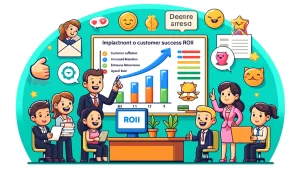
Tracking customer success is vital for any business that values client satisfaction and aims to foster long-term relationships. Here’s how to effectively measure customer success through key metrics:
Define Customer Success ROI
Customer success ROI should be defined according to the specific business model and industry context, as the approach and metrics will vary significantly between SaaS companies and those selling physical products.
For SaaS: Customer success involves continuous engagement to ensure ongoing usage and satisfaction. Key metrics (benefits) include Customer Lifetime Value (CLV), Net Revenue Retention (NRR), Net Promoter Score (NPS), and churn rate.
For Subscription-Based Product Financing: Customer success may focus more on ensuring product quality, timely delivery, subscription management, and included services. The key metric here is the retention rate.
After defining your customer success ROI, choose metrics that are outcome-focused and align with your customer success team’s specific goals. The selection should reflect your organization’s stage and growth strategy.
For example, In my experience in Early-Stage Startups: Retention rate, churn rate, NPS, product usage, and engagement metrics are crucial for early-stage startups in subscription-based product financing. These metrics provide a comprehensive view of customer loyalty, satisfaction, and behavior.
Align Metrics with Business Goals
Metrics must align with broader business goals to ensure customer success remains the focal point of business growth. This requires prioritizing metrics according to the company’s stage and goals at that stage. By iteratively refining these targets, you can ensure that all gaps in prioritization are addressed.
Tracking metrics consistently over time is essential. Establish regular reporting intervals, whether bi-weekly or monthly, to identify trends and improvement opportunities. Daily tracking helps reveal emerging gaps and risks while offering a strong understanding of progress.
Benchmark your current metrics against industry standards to identify areas of improvement and set realistic targets. Regularly analyze the data to optimize customer success strategies.
Communicate and Demonstrate Value
Clear communication and demonstration of customer success value is essential:Internally: Early in my career, I mistakenly believed sending a dashboard or a few slides regularly was sufficient to showcase the team’s work. However, clear communication is crucial, comprising at least 20% of our efforts. Every accomplishment, from small wins to achieving 110% NRR, should be communicated consistently to highlight the team’s indispensable value. This approach builds confidence among stakeholders and reinforces the importance of customer success.
Externally: When customers see their goals being met and their investments paying off, they are more likely to stay, expand their use of the product or service, and advocate for it.
By using these guidelines and metrics, you can comprehensively track customer success impact, ensure ROI, and demonstrate the immense value of a well-functioning customer success department.
